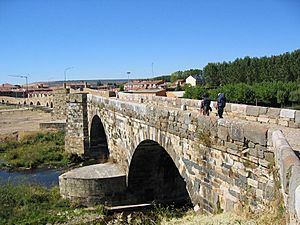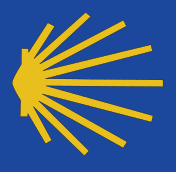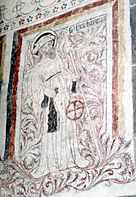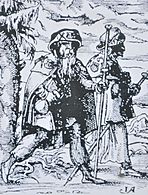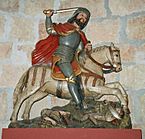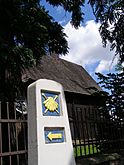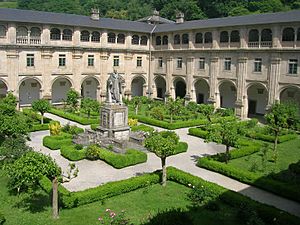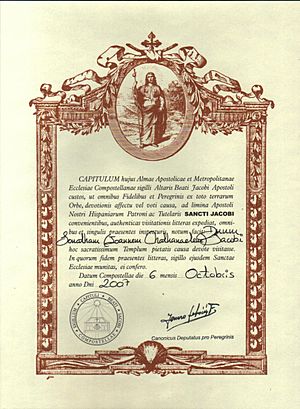Camino de Santiago facts for kids
Quick facts for kids Camino de Santiago |
|
|---|---|
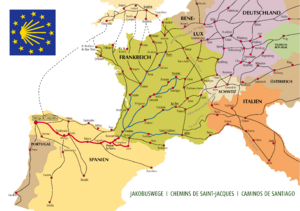
Map of the Way of St James in Europe
|
|
| Type | Pilgrims' way |
| UNESCO World Heritage Site | |
| Official name | Routes of Santiago de Compostela: Camino Francés and Routes of Northern Spain |
| Criteria | Cultural: (ii)(iv)(vi) |
| Inscription | 1993 (17th Session) |
| Extensions | 2015 |
| Buffer zone | 16,286 ha (62.88 sq mi) |
| UNESCO World Heritage Site | |
| Official name | Routes of Santiago de Compostela in France |
| Criteria | Cultural: (ii)(iv)(vi) |
| Inscription | 1998 (22nd Session) |
| Area | 97.21 ha (0.3753 sq mi) |
The Camino de Santiago, also known as the Way of St James, is a famous network of pilgrims' ways. These paths all lead to the cathedral of Santiago de Compostela in Galicia, northwestern Spain. People believe that the remains of Saint James the Great, one of Jesus's apostles, are buried there.
Many people still walk these routes today. Some do it for spiritual reasons, like a quiet retreat to help them grow. Others enjoy it for hiking, cycling, or as part of an organized tour.
The Way of St James started in the early 9th century. This was after the discovery of Saint James's remains. By the 10th century, it became a very important pilgrimage route for Christianity in the Middle Ages. In 1492, Pope Alexander VI officially named the Camino de Santiago one of the "three great pilgrimages of Christendom." The other two were to Jerusalem and to Rome (the Via Francigena).
In 1987, the Camino was named the first Cultural Route of the Council of Europe. It includes several routes in Spain, France, and Portugal. Since 2013, over 200,000 pilgrims walk the Camino each year. This number grows by more than 10 percent annually. Most pilgrims walk and often start from nearby cities. This means they walk for several days to reach Santiago. The French Way is the most popular route. The French Way and the Northern routes in Spain are on the UNESCO World Heritage List. The routes in France were added in 1998. They are important because of their history for Christianity and for showing how ideas and cultures were shared along the routes.
Contents
A Major Christian Pilgrimage
The Way of St James was one of the most important Christian pilgrimages in the later Middle Ages. Pilgrims could earn a special blessing called a plenary indulgence here. Other major pilgrimage routes included the Via Francigena to Rome and the journey to Jerusalem.
A legend says that St James's body was brought by boat from Jerusalem to northern Spain. He was then buried in what is now Santiago de Compostela. Another Spanish legend says Saint James preached the gospel in Spain. He returned to Judaea after seeing a vision of the Virgin Mary.
Pilgrims can choose from many routes to Santiago de Compostela. Traditionally, a pilgrimage starts from a person's home. It ends at the holy site. However, a few routes are considered the main ones. The route was very busy during the Middle Ages. But the Black Death, the Protestant Reformation, and wars in the 16th century caused it to decline. By the 1980s, only a few hundred pilgrims visited Santiago each year.
When St James's Day (July 25) falls on a Sunday, the cathedral declares a Holy or Jubilee Year. These Holy Years happen every 5, 6, or 11 years. The most recent ones were 1993, 1999, 2004, 2010, and 2021. The next Holy Years will be 2027 and 2032.
History of the Camino
Ancient Origins
The main pilgrimage route to Santiago follows an old Roman trade road. This road continued to the Atlantic coast of Galicia. It ended at Cape Finisterre. The Romans called this place Finisterrae, meaning "end of the world." This shows they thought it was the westernmost point of Europe. (Today, we know Cabo da Roca in Portugal is further west).
At night, the Milky Way galaxy seems to point the way overhead. Because of this, the route earned the nickname "Voie lactée," which is French for "Milky Way."
The Scallop Shell Symbol
The scallop shell is often found on the shores of Galicia. It has been the symbol of the Camino de Santiago for a long time. Over many centuries, the scallop shell has gained different meanings. These include symbolic, practical, and mythical ideas. Its importance might have come from pilgrims wanting a souvenir to take home.
There is a common myth about how the scallop shell became a symbol. It tells of Saint James's death. After he died, his body was carried by a ship, guided by an angel. The ship sailed to the Iberian Peninsula to be buried in what is now Santiago. As the ship neared land, a wedding was happening on the shore. The young groom was on horseback. His horse got scared when it saw the ship. Both horse and rider fell into the sea. But, by a miracle, they came out of the water alive. They were covered in seashells.
Because of its link to the Camino, the scallop shell came to mean pilgrimage. This includes journeys to a specific holy place or even to heaven. It reminds people that Christians are "pilgrims and strangers on the earth." You can see the scallop shell everywhere along the Camino. It often helps guide pilgrims. It is even more common to see pilgrims wearing the shell. This shows others that they are pilgrims. Most pilgrims get a shell at the start of their journey. They wear it throughout their walk. In the Middle Ages, the shell was more a sign of finishing the journey. It was not worn during the pilgrimage itself.
Pilgrims also used a pilgrim's staff. This was a walking stick used on the way to Santiago de Compostela. It usually had a hook to hang things from. Sometimes it had a crosspiece.
Medieval Journeys
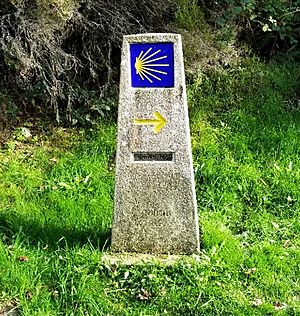
The first records of visits to the shrine at Santiago de Compostela are from the 9th century. This was during the time of the Kingdom of Asturias and Galicia. The pilgrimage became the most famous medieval journey. It became a custom for those returning from Compostela to bring back a Galician scallop shell. This proved they had completed the journey. This practice slowly made the scallop shell the symbol of a pilgrim.
The earliest pilgrims from beyond the Pyrenees mountains visited the shrine in the mid-11th century. But it was not until about a century later that many pilgrims from other countries regularly traveled there. The first records of pilgrims from England are from between 1092 and 1105. By the early 12th century, the pilgrimage was very well organized.
One important supporter of the pilgrimage in the 12th century was Pope Callixtus II. He started the Compostelan Holy Years.
The official guide back then was the Codex Calixtinus. This book was published around 1140. Its 5th book is still a key source for many modern guidebooks. The Codex lists four pilgrimage routes that start in France. They all meet at Puente la Reina. From there, a clear route crosses northern Spain. It connects cities like Burgos, Carrión de los Condes, Sahagún, León, Astorga, and Compostela.
Pilgrims' daily needs were met by a series of hospitals. These places helped develop the modern idea of a 'hospital.' Some Spanish towns still have names like Hospital de Órbigo. Catholic religious groups often ran these hospitals. They were also protected by kings and queens. Donations were encouraged. But many poorer pilgrims had few clothes and poor health. They often barely made it to the next hospital.
Romanesque architecture was a new style of church building. It used huge arches to handle the large crowds of religious people.
There were also souvenirs sold, like badges. Pilgrims often prayed to Saint Roch. Many pictures of him with the Cross of St James can still be seen along the Way. On the Camino, the cross is often seen with a Pilgrim's scallop to mark the path.
The pilgrimage route was possible because of the protection from the Kingdom of France. Most pilgrims came from France. French people settled in towns along the routes. Their names appear in old records. Pilgrims were cared for by people like Domingo de la Calzada, who later became a saint.
Pilgrims walked the Way of St James, sometimes for months or even years. They arrived at the great church in Compostela's main square. There, they honored St James. Many arrived with very little due to illness or robbery. Traditionally, pilgrims touch a pillar just inside the cathedral's doorway. So many have done this that the stone is visibly worn away.
The popular Spanish name for the Milky Way galaxy is El Camino de Santiago. A common medieval legend says the Milky Way was formed from the dust raised by traveling pilgrims.
Another legend says a hermit saw a bright star over a hillside. He told the bishop, who found a grave with three bodies. One, he said, was St James. So, the place was called "the field of the star" (Campus Stellae), which became "Compostela."
A different origin myth is in the Book of Saint James. It says the saint appeared in a dream to Charlemagne. He urged Charlemagne to free his tomb from the Moors. He showed him the way to follow by the route of the Milky Way.
Pilgrimage as Punishment
The Church used rituals like confession. These could lead to a priest asking a sinner to do a penance. This was a way to make up for their sins. Long pilgrimages were seen as a good way to make up for very serious sins.
Pilgrimages could also be ordered as a punishment for crimes. This practice is still sometimes used today. For example, in Flanders, there's a tradition. One prisoner is pardoned each year. But they must walk to Santiago, with a guard, wearing a heavy backpack.
The Camino in the 1700s
During the American Revolution, John Adams was sent by the Congress to Paris. He needed to get money for the American cause. His ship started leaking, so he and his two sons got off at Finisterre in 1779. From there, he followed the Way of St James in the opposite direction to get to Paris by land. He did not stop to visit Santiago, which he later regretted.
In his autobiography, Adams described the customs and places for pilgrims in the 18th century. He also shared a legend told to him:
I have always regretted that We could not find time to make a Pilgrimage to Saintiago de Compostella. We were informed ... that the Original of this Shrine and Temple of St. Iago was this. A certain Shepherd saw a bright Light there in the night. Afterwards it was revealed to an Archbishop that St. James was buried there. This laid the Foundation of a Church, and they have built an Altar on the Spot where the Shepherd saw the Light. In the time of the Moors, the People made a Vow, that if the Moors should be driven from this Country, they would give a certain portion of the Income of their Lands to Saint James. The Moors were defeated and expelled and it was reported and believed, that Saint James was in the Battle and fought with a drawn Sword at the head of the Spanish Troops, on Horseback. The People, believing that they owed the Victory to the Saint, very cheerfully fulfilled their Vows by paying the Tribute. ... Upon the Supposition that this is the place of the Sepulchre of Saint James, there are great numbers of Pilgrims, who visit it, every Year, from France, Spain, Italy and other parts of Europe, many of them on foot.
Modern-Day Pilgrimage
Many people think the pilgrimage to Santiago has continued without stopping since the Middle Ages. But few modern pilgrimages happened before 1957. That's when Walter Starkie's book The Road to Santiago was published. The Spanish government, led by Francisco Franco, helped bring back the pilgrimage. They wanted to promote Spain's Catholic history. It was only in the 1990s that the pilgrimage became as popular as it was in the Middle Ages.
Since then, hundreds of thousands of Christian pilgrims and others set out each year. They start from their homes or popular spots across Europe. They make their way to Santiago de Compostela. Most travel by foot. Some go by bicycle. A few even travel like medieval pilgrims, on horseback or by donkey. Besides religious pilgrims, many hikers walk the route for travel or sport. Many also see the experience as a spiritual break from modern life.
Popular Routes
There are many routes to Santiago. Here are a few of the main ones. For a full list, see: Camino de Santiago (route descriptions).
The Camino Francés, or French Way, is the most popular. The Via Regia is the last part of the French Way. Historically, most pilgrims came from France. They typically started from Arles, Le Puy, Paris, and Vézelay. Some came from Saint Gilles. Cluny, home to a famous medieval abbey, was another important meeting point for pilgrims. In 2002, it became part of the official European pilgrimage route.
Most Spanish people consider the French border in the Pyrenees mountains the natural starting point. The most common modern starting point on the Camino Francés is Saint-Jean-Pied-de-Port, on the French side of the Pyrenees. Roncesvalles on the Spanish side is also popular. The distance from Roncesvalles to Santiago de Compostela through León is about 800 km (500 mi).
The Camino Primitivo, or Original Way, is the oldest route. It was first used in the 9th century and begins in Oviedo. The Camino Portugués, or the Portuguese Way, is the second most popular route. It starts at the cathedral in Lisbon (about 610 km total). Or it can start at the cathedral in Porto in northern Portugal (about 227 km total). It crosses into Galicia at Valença.
The Camino del Norte, or Northern Way, is less traveled. It starts in the Basque city of Irun on the border with France, or sometimes in San Sebastián. This route is less popular because it has many changes in elevation. The Camino Francés is mostly flat. The Northern Way follows the coast along the Bay of Biscay until it gets close to Santiago. It does not pass through as many historical places as the Camino Francés. But it has cooler summer weather. People believe this route was first used by pilgrims to avoid traveling through areas controlled by Muslims in the Middle Ages.
The Central European Camino was restarted after the fall of the Berlin Wall. Medieval routes like Camino Baltico and the Via Regia in Poland go through present-day Poland. They reach as far north as the Baltic states, including Vilnius. They also go east to present-day Ukraine, including Lviv, Sandomierz, and Kraków.
Places to Stay
In Spain, France, and Portugal, pilgrims' hostels offer beds in dormitories. These are for pilgrims who have a credencial (a special passport). In Spain, these places are called refugio or albergue. They are similar to youth hostels. In France, they are called gîtes d'étape.
Hostels can be run by a local church, the local government, private owners, or pilgrim groups. Sometimes, these refugios are in monasteries. For example, the one in the Monastery of San Xulián de Samos is run by monks. There is also one in Santiago de Compostela.
The last hostel on the route is the famous Hostal de los Reyes Católicos. It is in the Plaza del Obradoiro, across from the Cathedral. It was built as a hospice and hospital for pilgrims. It was built by Queen Isabella I and King Ferdinand II, the Catholic Monarchs. Today, it is a fancy 5-star Parador hotel. It still provides free services to a limited number of pilgrims each day.
The Credencial (Pilgrim's Passport)
Most pilgrims buy and carry a document called the credencial. This document lets them stay overnight in hostels along the route. It is also known as the "pilgrim's passport." The credencial gets stamped with an official St. James stamp in each town or refugio where the pilgrim stays.
It gives pilgrims a record of where they ate or slept. It also proves to the Pilgrim's Office in Santiago that they followed an official route. This means the pilgrim can get a compostela, which is a certificate for completing the pilgrimage.
The Compostela Certificate
The compostela is a certificate given to pilgrims when they finish the Way. To earn it, you need to walk at least 100 km (about 62 miles). Or you can cycle at least 200 km (about 124 miles). For walkers, the closest easy starting point is Sarria. It has good bus and train connections to other places in Spain.
Pilgrims who arrive in Santiago de Compostela and have walked at least the last 100 km (62 mi), or cycled 200 km (120 mi), can get a compostela. They must show their credencial and say their reason was at least partly religious. The Pilgrim's Office in Santiago gives out the certificate.
The compostela has been a special blessing since the Early Middle Ages. It still is today, especially during Holy Years. The English translation of the certificate reads:
The CHAPTER of this holy apostolic and metropolitan Church of Compostela, guardian of the seal of the Altar of the blessed Apostle James, in order that it may provide authentic certificates of visitation to all the faithful and to pilgrims from all over the earth who come with devout affection or for the sake of a vow to the shrine of our Apostle St. James, the patron and protector of Spain, hereby makes known to each and all who shall inspect this present document that [Name]
has visited this most sacred temple for the sake of pious devotion. As a faithful witness of these things I confer upon him [or her] the present document, authenticated by the seal of the same Holy Church.
Given at Compostela on the [day] of the month of [month] in the year of the Lord [year].
Deputy Canon for Pilgrims
For those with non-religious reasons, a simpler certificate in Spanish says:
La S.A.M.I. Catedral de Santiago de Compostela le expresa su bienvenida cordial a la Tumba Apostólica de Santiago el Mayor; y desea que el Santo Apóstol le conceda, con abundancia, las gracias de la Peregrinación.
This means:
The Holy Apostolic Metropolitan Cathedral of Santiago de Compostela expresses its warm welcome to the Tomb of the Apostle St. James the Greater; and wishes that the holy Apostle may grant you, in abundance, the graces of the Pilgrimage.
The Pilgrim's Office gives out over 100,000 compostelas each year. Pilgrims from more than 100 countries receive them. But not everyone who walks the Camino gets one. The rules for getting a compostela are:
- 1) Make the Pilgrimage for religious or spiritual reasons, or at least be searching for something.
- 2) Do the last 100 km (62 miles) on foot or horseback, or the last 200 km (124 miles) by bicycle.
- 3) Collect a certain number of stamps on your credencial.
Pilgrim's Mass
 Green bars are holy years |
A Pilgrim's Mass is held in the Cathedral of Santiago de Compostela every day. It takes place at 12:00 PM and 7:30 PM. Pilgrims who received their compostela the day before have their home countries and starting points announced. The Botafumeiro, one of the world's largest censers, is used during certain special church days. It is also used every Friday, except Good Friday, at 7:30 PM. Priests offer the Sacrament of Penance, or confession, in many languages. In the Holy Year of 2010, the Pilgrim's Mass was held four times a day. This was to serve the larger number of pilgrims arriving that year.
The Camino as Tourism
The Xunta de Galicia (Galicia's local government) promotes the Way as a tourist activity. They especially do this in Holy Compostela Years. These are years when July 25 falls on a Sunday. After Galicia's efforts for the Holy Year of 1993, the number of pilgrims has been growing steadily. The most recent Holy Year was in 2021. Over 272,000 pilgrims made the trip in 2010. The next Holy Year pilgrimage will be in 2027.
| Year | Pilgrims |
|---|---|
| 2022 | 437,507 |
| 2021 | 178,9121, 4 |
| 2020 | 54,1444 |
| 2019 | 347,578 |
| 2018 | 327,378 |
| 2017 | 301,036 |
| 2016 | 277,915 |
| 2015 | 262,458 |
| 2014 | 237,886 |
| 2013 | 215,880 |
| 2012 | 192,488 |
| 2011 | 179,919 |
| 2010 | 272,7031 |
| 2009 | 145,877 |
| 2008 | 125,141 |
| 2007 | 114,026 |
| 2006 | 100,377 |
| 2005 | 93,924 |
| 2004 | 179,9441 |
| 2003 | 74,614 |
| 2002 | 68,952 |
| 2001 | 61,418 |
| 2000 | 55,004³ |
| 1999 | 154,6131 |
| 1998 | 30,126 |
| 1997 | 25,179 |
| 1996 | 23,218 |
| 1995 | 19,821 |
| 1994 | 15,863 |
| 1993 | 99,4361 |
| 1992 | 9,764 |
| 1991 | 7,274 |
| 1990 | 4,918 |
| 1989 | 5,760² |
| 1988 | 3,501 |
| 1987 | 2,905 |
| 1986 | 1,801 |
| 1985 | 690 |
| 1 Holy Years (Xacobeo/Jacobeo) 2 4th World Youth Day in Santiago de Compostela 3 Santiago named European Capital of Culture 4 Years of COVID-19_pandemic Source: The archives of Santiago de Compostela. |
|
Images for kids
See also
 In Spanish: Camino de Santiago para niños
In Spanish: Camino de Santiago para niños
- Camino de Santiago (route descriptions)
- Codex Calixtinus
- Confraternity of Saint James
- Cross of Saint James
- Dominic de la Calzada
- Hajj
- holy door
- Japan 100 Kannon Pilgrimage
- Kumano Kodo
- Mary Remnant
- Order of Santiago
- Palatine Ways of St. James
- Path of Miracles
- Shikoku Pilgrimage
- Via Jacobi
- Walking the Camino: Six Ways to Santiago
- World Heritage Sites of the Routes of Santiago de Compostela in France




